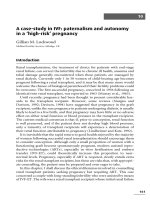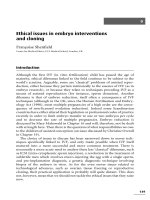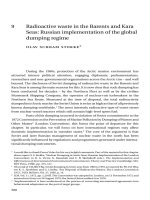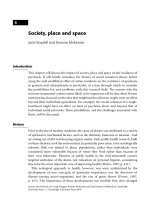Math k investigations in number, data, and space
Bạn đang xem bản rút gọn của tài liệu. Xem và tải ngay bản đầy đủ của tài liệu tại đây (9.55 MB, 62 trang )
Math Words and Ideas
Read Together
How Many? (0, 1, 2)
zero
0
zero balls
one
0
1
1
one ball
two
2
2
two balls
Note to Teacher: Encourage students to count and compare multiple representations of the
same number: the word (e.g. two), the numeral (e.g. 2) and the quantity (e.g. 2 dots, 2 balls,
2 pencils) to make sure they are the same amount.
4
four
Math Words and Ideas
Read Together
How Many? (3, 4)
three
3
3
three balls
four
4
4
four balls
Note to Teacher: Encourage students to count and compare multiple representations of the
same number: the word (e.g. four), the numeral (e.g. 4) and the quantity (e.g. 4 dots, 4 balls,
4 pencils) to make sure they are the same amount.
five
5
Math Words and Ideas
Read Together
How Many? (5, 6)
five
5
5
five balls
six
6
6
six balls
Note to Teacher: Encourage students to count and compare multiple representations of the
same number: the word (e.g. six), the numeral (e.g. 6) and the quantity (e.g. 6 dots, 6 balls,
6 pencils) to make sure they are the same amount.
6
six
Math Words and Ideas
Read Together
How Many? (7)
seven
7
7
seven balls
Note to Teacher: Encourage students to count and compare multiple representations of the
same number: the word (e.g. seven), the numeral (e.g. 7) and the quantity (e.g. 7 dots, 7 balls,
7 pencils) to make sure they are the same amount.
seven
7
Math Words and Ideas
Read Together
How Many? (8)
eight
8
8
eight balls
Note to Teacher: Encourage students to count and compare multiple representations of the
same number: the word (e.g. eight), the numeral (e.g. 8) and the quantity (e.g. 8 dots, 8 balls,
8 pencils) to make sure they are the same amount.
8
eight
Math Words and Ideas
Read Together
How Many? (9)
nine
9
9
nine balls
Note to Teacher: Encourage students to count and compare multiple representations of the
same number: the word (e.g. nine), the numeral (e.g. 9) and the quantity (e.g. 9 dots, 9 balls,
9 pencils) to make sure they are the same amount.
nine
9
Math Words and Ideas
Read Together
How Many? (10)
ten
10
10
ten balls
Note to Teacher: Encourage students to count and compare multiple representations of the
same number: the word (e.g. ten), the numeral (e.g. 10) and the quantity (e.g. 10 dots, 10 balls,
10 pencils) to make sure they are the same amount.
10 ten
Math Words and Ideas
Read Together
Numbers: 0 to 10
0
zero
1
one
2
two
3
three
4
four
5
five
6
six
7
seven
8
eight
9
nine
10
ten
eleven
11
Math Words and Ideas
Read Together
Numbers: 11 to 19
11
eleven
12
twelve
13
thirteen
14
fourteen
15
fifteen
16
sixteen
17
seventeen
18
eighteen
19
nineteen
12 twelve
Math Words and Ideas
Read Together
Numbers: 20 to 25
20
twenty
21
twenty-one
22
twenty-two
23
twenty-three
24
twenty-four
25
twenty-five
thirteen
13
Math Words and Ideas
Read Together
Numbers: 26 to 30
26
twenty-six
27
twenty-seven
28
twenty-eight
29
twenty-nine
30
thirty
14 fourteen
Math Words and Ideas
Read Together
Calendar
A calendar is a tool for keeping track of time and events.
month
days of
the week
Sunday
September 2008
Monday
Tuesday
Wednesday
1
2
3
7
8
9
10
14
15
16
21
22
23
28
29
30
First
Day of Fall
Field
Trip to the Park
year
Thursday
4
Friday
Saturday
5
6
11
12
13
17
18
19
20
24
25
26
27
Family
Breakfast
First Day
of School
What will happen on Tuesday, September 16?
What day of the week is the first day of school?
When is the first day of fall?
Note to Teacher: Use this page to help students make sense of the calendar as tool for keeping
track of time and events.
fifteen
15
Math Words and Ideas
Read Together
Who is First? Who is Next?
ninth, 9th
tenth, 10th
eighth, 8th
seventh,
7th
first, 1st
sixth,
6th
second,
2nd
fifth, 5th
third, 3rd
fourth, 4th
Note to Teacher: When they line up, ask students to use ordinals to identify their position in line
(e.g. first, second, etc.).
16 sixteen
Math Words and Ideas
Read Together
Counting
People count every day. They count to find out how many.
How many balls?
1
4
2
5
3
6
7
10 balls
8
9
10
When do you count? What do you like to count?
Note to Teacher: Because counting is the foundation for much of the number work that
Kindergarteners do, encourage them to discuss why they count.
seventeen
17
Math Words and Ideas
Read Together
More Counting
How many students are here today?
20 students are here today.
How many students are in your class?
Note to Teacher: Who Is in School Today? Session 1.1. Use this page to show that we use
numbers both to count a set of objects (1, 2, 3, . . . 20) and to describe the quantity of those
objects (the total is 20).
18 eighteen
Math Words and Ideas
Read Together
Ways to Count
When you count, you say one number for each object.
You need to keep track of what you are counting.
The last number you say is the total. The total tells you
how many are in the group.
Look at how some children count.
Jack puts each button in a cup
as he counts it.
Three . . .
Abby moves each button as she
counts it.
Four . . .
Kiyo puts the buttons in a row
to count them.
Eight . . .
What do you do when you count?
Note to Teacher: Who Is in School Today? Session 2.5. Use these examples in your first
discussion about strategies for counting the objects in the Counting Jar and whenever you
discuss how students count.
nineteen
19
Math Words and Ideas
Read Together
Counting Jar
Step 1. Count how many.
Cubes
Step 2. Make the same amount.
Hugo
Beth
Step 3. Show how many.
Note to Teacher: Who Is in School Today? Session 2.1. Encourage students to use this page
when they are working on the Counting Jar to help them remember the steps of the activity.
20 twenty
Math Words and Ideas
Read Together
More
Who has more?
Emma’s card
Jason’s card
3
6
Jason has more than Emma. 6 is more than 3.
Who has more?
Hugo’s cube tower
Lisa’s cube tower
Hugo has more than Lisa. 5 is more than 2.
Who has more? How do you know?
Rebecca’s cube train
Russell’s cube train
Note to Teachers: Counting and Comparing, Sessions 2.4 and 2.5. As you review this page
and the following two pages with students, ask them to find a card or create a cube tower that is
more, fewer, or equal to a given quantity.
twenty-one
21
Math Words and Ideas
Read Together
Fewer
Who has fewer?
Jae’s card
Kaitlyn’s card
4
8
Jae has fewer than Kaitlyn. 4 is less than 8.
Who has fewer?
Tammy’s cube tower
Mitchell’s cube tower
Mitchell has fewer than Tammy. 3 is less than 6.
Who has fewer?
Carmen’s cube train
Kyle’s cube train
Note to Teachers: Counting and Comparing, Sessions 2.4 and 2.5. As you review this page,
the previous page, and the following page with students, ask them to find a card or create a cube
tower that is more, fewer, or equal to a given quantity.
22 twenty-two
Math Words and Ideas
Read Together
Equal
Who has fewer?
Mia’s card
Victor’s card
5
5
Mia and Victor have the same amount.
5 is the same amount as 5. 5 is equal to 5.
Tammy’s cube tower
Mitchell’s cube tower
Sarah and Yoshio have equal amounts.
6 is the same amount as 6. 6 is equal to 6.
Can you show the same amount as Beth?
Beth’s cube train
Note to Teachers: Counting and Comparing, Sessions 2.4 and 2.5. As you review this page
and the previous two pages with students, ask them to find a card or create a cube tower that is
more, fewer, or equal to a given quantity.
twenty-three
23
Math Words and Ideas
Read Together
Ordering Fewest to Most
Brad grabbed four handfuls of cubes.
He built towers and counted the cubes.
7
4
5
3
He put the towers in order from fewest to most.
Green is the
smallest tower.
3 is the fewest.
3
4
5
7
Yellow is the
biggest tower.
7 is the most.
Build a tower that has more than 7 cubes. How many
cubes are in your tower?
Note to Teacher: Counting and Comparing, Sessions 2.10 and 2.11. Use this example to help
students think about ordering quantities from fewest to most.
24 twenty-four
Math Words and Ideas
Read Together
One More
Here are five stars.
1
2
3
4
5
4
5
One more is six.
1
2
3
Here are seven crayons.
1
2
3
4
5
6
6
One more is eight.
7
1
2
3
4
5
6
7
8
Here are 4 apples. If you
had 1 more, how many
apples would you have?
Note to Teacher: Measuring and Counting, Session 2.3. As students work on the concepts
of one more and one fewer, find and use other contexts, including the number line, that illustrate
what happens when you add one more or take one away.
25
Math Words and Ideas
Read Together
One Fewer
Here are five stars.
1
2
3
4
5
One fewer is four.
1
2
3
4
Here are seven crayons. One fewer is six.
1
2
3
4
5
6
7
1
2
3
4
5
6
Here are 4 apples. If you
had 1 fewer, how many
apples would you have?
1
2
3
4
Note to Teacher: Measuring and Counting, Session 2.3. As students work on the concepts
of one more and one fewer, find and use other contexts, including the number line, that illustrate
what happens when you add one more or take one away.
26
Math Words and Ideas
Read Together
Five Tiles
These students are looking at
this arrangement of 5 tiles.
Here’s how they know that
there are 5.
1
3
1
2
3
I counted
5 tiles.
4
1
1 and 3
and 1 is 5.
5
1
2
5
2
I saw 2,
2, and 1.
First I saw
3, then 4, 5.
4
2ϩ2ϩ1ϭ5
How do you know that there are 5?
Note to Teacher: Measuring and Counting, Sessions 4.1, 4.2, 4.4, 4.7, 4.9 and How Many
Do You Have?, Sessions 1.1, 1.2, 1.3, 1.4, 1.6, and 1.7. Use this page to discuss the fact that
there are different ways to arrange a certain quantity of tiles, and to show students that there
are different ways to see and describe the arrangements numerically.
twenty-seven
27
Math Words and Ideas
Read Together
Ways to Make 6
There are different ways to make a number.
Here are some ways to make 6.
Toss the Chips
These students tossed 6 two-color counters.
Some landed on the red side. Some landed on the
yellow side.
3 red and 3 yellow
2 red and 4 yellow
Six Tiles
These students arranged 6 tiles.
3 and 3
1 and 5
2 and 2 and 2
3 and 3
1 and 2 and 3
Can you think of another way to make 6?
Note to Teacher: How Many Do You Have?, Session 4.6. Use these pages to help students
see that there are certain combinations that make a number, no matter which material they are
using or what game they are playing. Encourage students to find combinations that appear more
than once.
28 twenty-eight









